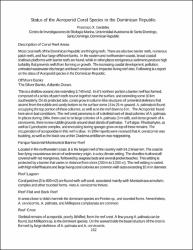| Author | Geraldes, Francisco X. | |
| Accessioned date | 2025-02-23T00:07:26Z | |
| Available date | 2025-02-23T00:07:26Z | |
| Year | 2003 | |
| Citation | Geraldes, F. X. (2003). Status of the acroporid coral species in the Dominican Republic. Proceedings of the Caribbean Acropora Workshop: Potential Application of the U.S. Endangered Species Act as a Conservation Strategy. NOAA Technical Memorandum NMFS-OPR-24 (pp. 152-155). Silver Spring, USA: National Oceanic and Atmospheric Administration. Recuperado de: | es |
| URI | https://bvearmb.do/handle/123456789/5853 | |
| Abstract | Most coral reefs of the Dominican Republic are fringing reefs. There are also two barrier reefs, numerous patch reefs, and four large offshore banks. In the eastern and northwestern coasts, broad coastal shallow platforms with barrier reefs are found, while in other places terrigenous sediments produce high turbidity that prevents reefs from forming or growing. The increasing coastal development, pollution, untreated wastewater discharges, and beach erosion have impacted living reef sites. Following is a report on the status of Acroporid species in the Dominican Republic. | es |
| Language | English | es |
| Published | Proceedings of the Caribbean Acropora Workshop: Potential Application of the U.S. Endangered Species Act as a Conservation Strategy. NOAA Technical Memorandum NMFS-OPR-24 (pp. 152-155). Silver Spring, USA: National Oceanic and Atmospheric Administration | es |
| Rights | © US National Oceanic and Atmospheric Administration (NOAA). Available at: https://www.fisheries.noaa.gov/ | es |
| Subject | Recursos naturales - República Dominicana | es |
| Subject | Recursos costeros y marinos | es |
| Subject | Arrecifes de coral | es |
| Title | Status of the acroporid coral species in the Dominican Republic | es |
| Material type | Article | es |
| Type of content | Scientific research | es |
| Access | Open | es |
| Audience | Technicians, professionals and scientists | es |


